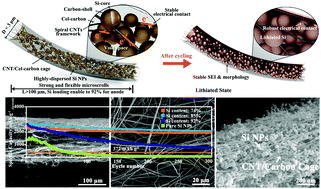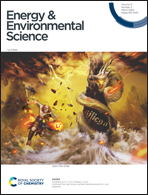A binder-free high silicon content flexible anode for Li-ion batteries†
Abstract
Despite the high theoretical capacity of Si anodes, their huge volume change and poor electrical connectivity must be overcome by decreasing the feature sizes of the Si particles to the nanoscale and compositing them with highly conductive carbon materials. To ensure the mechanical integrity of the electrodes with uniform dispersion and good electrical contact of the nano-silicon, the industry has to use a relatively low amount of Si (<15% by mass) in commercial anodes. Such a low Si content severely weakens the capacity advantage of silicon at the electrode level. Here, we designed a cellulose-based topological microscroll by the self-rolling of cellulose nanosheets to form a binder-free, flexible, and free-standing electrode comprising an unprecedented 92% silicon content. In the microscroll, carbon-coated silicon nanoparticles are anchored on conductive carbon nanotubes and subsequently confined in cellulose carbon rolls with enough internal voids to accommodate the volume expansion of silicon; thus, a uniform dispersion of silicon with high reactivity was achieved. This structure shows an ultrahigh electrode-specific capacity of 2700 mA h g−1, excellent cycling stability under a high silicon content of 85% (>2000 mA h g−1 after 300 cycles) and a commercial-level areal capacity (5.58 mA h cm−2). This strategy offers a new way to design electrodes with a high active material content for high performance batteries.

- This article is part of the themed collection: Energy & Environmental Science Cover Art


 Please wait while we load your content...
Please wait while we load your content...